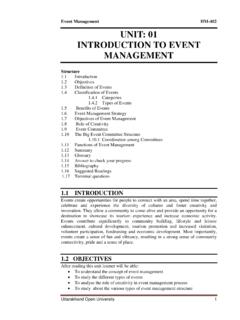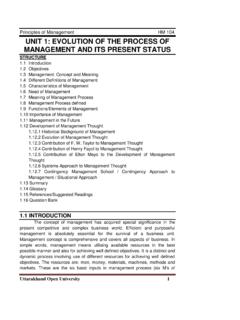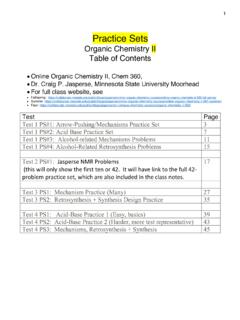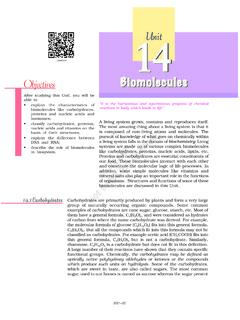Transcription of HETEROCYCLIC COMPOUNDS - Uttarakhand Open University
1 Lecture note- 3 Organic Chemistry CHE 502 HETEROCYCLIC COMPOUNDS Co-Coordinator Dr. Shalini Singh DEPARTMENT OF CHEMISTRY Uttarakhand OPEN University UNIT 4: HETEROCYCLIC COMPOUNDS - I CONTENTS Objectives Introduction Classification of HETEROCYCLIC COMPOUNDS Nomenclature of HETEROCYCLIC COMPOUNDS Molecular orbital picture Structure and aromaticity of pyrrole, furan, thiophene and pyridine Methods of synthesis properties and chemical reactions of Pyrrole, Furan, Thiophene and Pyridine Comparison of basicity of Pyridine, Piperidine and Pyrrole Summary Terminal Question OBJECTIVES In this unit learner will be able to Know about the most important simple HETEROCYCLIC ring systems containing heteroatom and their systems of nomenclature and numbering.
2 Understand and discuss the reactivity and stability of hetero aromatic COMPOUNDS . Study the important synthetic routes and reactivity for five and six member hetero aromatic COMPOUNDS . Understand the important physical and chemical properties of five and six member hetero aromatic COMPOUNDS . Know about the applications of these hetero aromatic COMPOUNDS in the synthesis of important industrial and pharmaceutical COMPOUNDS INTRODUCTION HETEROCYCLIC compound is the class of cyclic organic COMPOUNDS those having at least one hetero atom ( atom other than carbon) in the cyclic ring system. The most common heteroatoms are nitrogen (N), oxygen (O) and sulphur (S). HETEROCYCLIC COMPOUNDS are frequently abundant in plants and animal products; and they are one of the important constituent of almost one half of the natural organic COMPOUNDS known.
3 Alkaloids, natural dyes, drugs, proteins, enzymes etc. are the some important class of natural HETEROCYCLIC COMPOUNDS . HETEROCYCLIC COMPOUNDS can be easily classified based on their electronic structure. HETEROCYCLIC COMPOUNDS are primarily classified as saturated and unsaturated. The saturated HETEROCYCLIC COMPOUNDS behave like the acyclic derivatives with modified steric properties. Piperidine and tetrehydrofuran are the conventional amines and ethers of this category. However, unsaturated HETEROCYCLIC COMPOUNDS of 5- and 6- member rings have been studied extensively because of their unstrained nature. The unstrained unsaturated HETEROCYCLIC COMPOUNDS include Pyridine, Thiophene, Pyrrole, Furan and their benzo fused derivatives. Quinoline, Isoquinoline, Indole, Benzothiophene, and Benzofuran are some important example of benzo fused heterocycles.
4 HETEROCYCLIC COMPOUNDS have a wide application in pharmaceuticals, agrochemicals and veterinary products. Many HETEROCYCLIC COMPOUNDS are very useful and essential for human life. Various COMPOUNDS such as hormones, alkaloids antibiotic, essential amino acids, hemoglobin, vitamins, dyestuffs and pigments have HETEROCYCLIC structure. In the present unit, students would be able to learn about the common five and six membered HETEROCYCLIC COMPOUNDS , such as Pyrrole, Furan, Thiophene, Pyridine and Piperidine etc. CLASSIFICATION OF HETEROCYCLIC COMPOUNDS Based on the structural and electronic arrangement the HETEROCYCLIC COMPOUNDS may be classified into two categories. i. Aliphatic HETEROCYCLIC COMPOUNDS ii. Aromatic HETEROCYCLIC COMPOUNDS The aliphatic HETEROCYCLIC COMPOUNDS are the cyclic amines, cyclic amides, cyclic ethers and cyclic thioethers.
5 Aliphatic heterocycles those do not contain double bonds are called saturated heterocycles. The properties of aliphatic heterocycles are mainly affected by the ring strain. Examples of aliphatic HETEROCYCLIC COMPOUNDS are shown in figure 1. HNAziridineOEthylene oxideSThiiraneOOxetaneNHAzetidineSThieta neOTetrahydrofuran(THF)OO1,2-dioxaneOO1, 4-dioxaneNHPyrrolidineNHPiperidine Figure 1. Examples of aliphatic HETEROCYCLIC COMPOUNDS However, aromatic HETEROCYCLIC COMPOUNDS are analogous of benzene. The aromatic HETEROCYCLIC COMPOUNDS also follow the Huckel s rule. According to Huckel s rule an aromatic COMPOUNDS must be cyclic in nature with planar geometry due to conjugate double bonds and must have (4n+2) electrons. Examples of aromatic HETEROCYCLIC COMPOUNDS are shown in figure 2. OFuranNHPyrroleSThiopheneNPyridineNHIndo leOBenzofuranHNCarbazoleNQuinolineNIsoqu inolineNHNI midazoleONOxazoleNHNP yrazoleNNPyridazineNNPyrimidineNHNNNP urine Figure 2.
6 Examples of aromatic HETEROCYCLIC COMPOUNDS A hetero cyclic ring may comprise of three or more than three atoms, which may be saturated or unsaturated. Also HETEROCYCLIC ring may contain more than one heteroatom which may be either similar or different. Based on the variety of structure, the HETEROCYCLIC COMPOUNDS may also be divided in to three categories. 1. Five membered HETEROCYCLIC COMPOUNDS : These HETEROCYCLIC COMPOUNDS may be considered to be derived from benzene by replacing one C=C bond by a hetero atom with a lone pair of electron. Based on number of hetero atom present in the cyclic ring this class of HETEROCYCLIC COMPOUNDS may be further subdivided in to following categories. a). HETEROCYCLIC COMPOUNDS with one hetero atom: Common examples of this class of COMPOUNDS are furan, thiophene and pyrrole (Figure 3). OFuranNHPyrroleSThiophene Figure 3.
7 Five member HETEROCYCLIC COMPOUNDS with one hetero atom b). HETEROCYCLIC COMPOUNDS with more than one hetero atom: These hetero atoms may be same or different. Common examples of this category of HETEROCYCLIC COMPOUNDS are pyrazole, imidazole, thiazole, oxazole, triazole and tetrazole etc (Figure 4). NHNNHNNNHNONI midazoleOxazolePyrazoleSNNNNHNT hiazoleTraizoleTetrazole Figure 4. Five member HETEROCYCLIC COMPOUNDS with two hetero atom 2. Six membered HETEROCYCLIC COMPOUNDS : This class of COMPOUNDS may be considered to be derived from the replacement of a carbon atom of benzene by an iso-electronic atom. Similar to the five membered HETEROCYCLIC COMPOUNDS , the six membered HETEROCYCLIC COMPOUNDS may also be subdivided in to following categories. a). HETEROCYCLIC COMPOUNDS with one hetero atom: Common examples of this class of COMPOUNDS are pyridine, pyran, thiopyran etc (Figure 5).
8 NOS4H-thiopyran4H-pyranpyridine Figure 5. Six member HETEROCYCLIC COMPOUNDS with one hetero atom b). HETEROCYCLIC COMPOUNDS with more than one hetero atom: Common examples of this class of COMPOUNDS are pyridazine, pyrimidine, pyrazine etc (Figure 6). NNNNNN pyridazinepyrimidinepyrazine Figure 6. Six member HETEROCYCLIC COMPOUNDS with more than one hetero atom 3. Fused or condensed HETEROCYCLIC COMPOUNDS : This class of compound may consist two or more fused rings which may be partly carbocyclic and partly HETEROCYCLIC , common examples of this category of HETEROCYCLIC COMPOUNDS are Indole, Quinoine, Isoquionoline, Cabazole etc; or may be completely HETEROCYCLIC , common examples of this category of HETEROCYCLIC COMPOUNDS are purine, pteridine etc (Figure 7). NHIndoleOBenzofuranHNCarbazoleNQuinoline NIsoquinolineNHNNNP urineNNNNP teridine Figure 7.
9 Fused or condensed HETEROCYCLIC COMPOUNDS NOMENCLATURE OF HETEROCYCLIC COMPOUNDS The nomenclature of HETEROCYCLIC COMPOUNDS is divided in to two categories, a) Trivial method of nomenclature and, b) Systematic method of nomenclature. However, most of the HETEROCYCLIC COMPOUNDS are known by their common trivial names. TRIVIAL METHOD OF NOMENCLATUTRE: During the early days of organic chemistry, names of the HETEROCYCLIC organic COMPOUNDS were given based on their occurrence, their first preparation and some characteristic properties. HETEROCYCLIC COMPOUNDS were named on the basis of their source from which the compound was obtained. Thus the name depended on the source of the compound. For example picoline; picoline is derived from coaltar. This is based on Lattin word pictus means tarry. NCH3 Picoline HETEROCYCLIC COMPOUNDS were also named on the basis of their characteristic properties.
10 For example, pyrrole; which is basic in nature; the name of pyrrole was originated from the Greek word for fiery red because of characteristic colour which the compound gives with pine splint dipped in hydrochloric acid. NHPyrrole Similarly, the name Furfural is given based on it s source. Furfural means barn oil. Furfural was isolated from the distillation of barn. OCHOF urfural The trivial nomenclature was the first nomenclature method which has a significant role in the development of HETEROCYCLIC chemistry. However, this system has some disadvantages too. The trivial system does not give any structural information about the compound. At present just over 60 trivial names survive and recognized by IUPAC system of nomenclature. These recognized names are, however, significant because they are used as basis for constructing other COMPOUNDS , more systematic names for polycyclic COMPOUNDS and/or their derivatives.

















